ACCTG 101 Assignment 02: Financial Statement and Budgeting Analysis
VerifiedAdded on 2023/04/04
|10
|1643
|265
Homework Assignment
AI Summary
This document provides a detailed solution for ACCTG 101 Assignment 02, a homework assignment from the University of Auckland's first semester of 2019. The assignment covers three main areas: financial statement analysis, cost-volume-profit (CVP) analysis, and budgeting. The financial statement analysis includes horizontal and vertical analysis of Auckland Airport's income and expenses over a four-year period, along with the calculation and interpretation of key financial ratios like debt-to-equity, interest coverage, profit margin, and asset turnover. The CVP analysis involves calculating break-even points and determining the impact of different cost structures on profitability. The budgeting section includes creating an inventory purchase budget and a cash budget, along with a discussion of the advantages and disadvantages of just-in-time inventory management. The solution provides clear workings and explanations for each question, demonstrating a strong understanding of accounting principles and financial analysis techniques. The assignment is a comprehensive assessment of fundamental accounting concepts and their practical application.
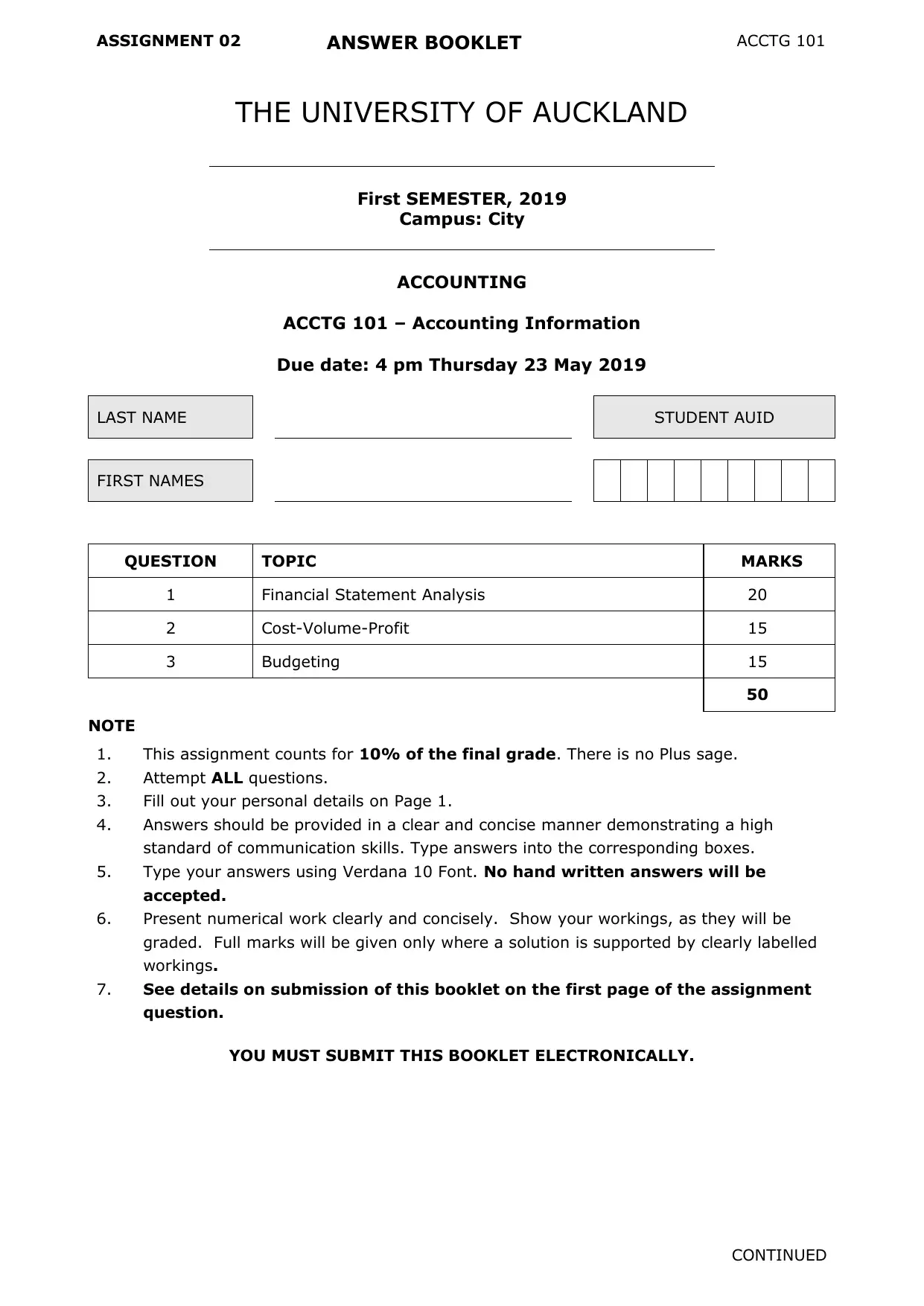
ASSIGNMENT 02 ANSWER BOOKLET ACCTG 101
THE UNIVERSITY OF AUCKLAND
First SEMESTER, 2019
Campus: City
ACCOUNTING
ACCTG 101 – Accounting Information
Due date: 4 pm Thursday 23 May 2019
LAST NAME STUDENT AUID
FIRST NAMES
QUESTION TOPIC MARKS
1 Financial Statement Analysis 20
2 Cost-Volume-Profit 15
3 Budgeting 15
50
NOTE
1. This assignment counts for 10% of the final grade. There is no Plus sage.
2. Attempt ALL questions.
3. Fill out your personal details on Page 1.
4. Answers should be provided in a clear and concise manner demonstrating a high
standard of communication skills. Type answers into the corresponding boxes.
5. Type your answers using Verdana 10 Font. No hand written answers will be
accepted.
6. Present numerical work clearly and concisely. Show your workings, as they will be
graded. Full marks will be given only where a solution is supported by clearly labelled
workings.
7. See details on submission of this booklet on the first page of the assignment
question.
YOU MUST SUBMIT THIS BOOKLET ELECTRONICALLY.
CONTINUED
THE UNIVERSITY OF AUCKLAND
First SEMESTER, 2019
Campus: City
ACCOUNTING
ACCTG 101 – Accounting Information
Due date: 4 pm Thursday 23 May 2019
LAST NAME STUDENT AUID
FIRST NAMES
QUESTION TOPIC MARKS
1 Financial Statement Analysis 20
2 Cost-Volume-Profit 15
3 Budgeting 15
50
NOTE
1. This assignment counts for 10% of the final grade. There is no Plus sage.
2. Attempt ALL questions.
3. Fill out your personal details on Page 1.
4. Answers should be provided in a clear and concise manner demonstrating a high
standard of communication skills. Type answers into the corresponding boxes.
5. Type your answers using Verdana 10 Font. No hand written answers will be
accepted.
6. Present numerical work clearly and concisely. Show your workings, as they will be
graded. Full marks will be given only where a solution is supported by clearly labelled
workings.
7. See details on submission of this booklet on the first page of the assignment
question.
YOU MUST SUBMIT THIS BOOKLET ELECTRONICALLY.
CONTINUED
Paraphrase This Document
Need a fresh take? Get an instant paraphrase of this document with our AI Paraphraser
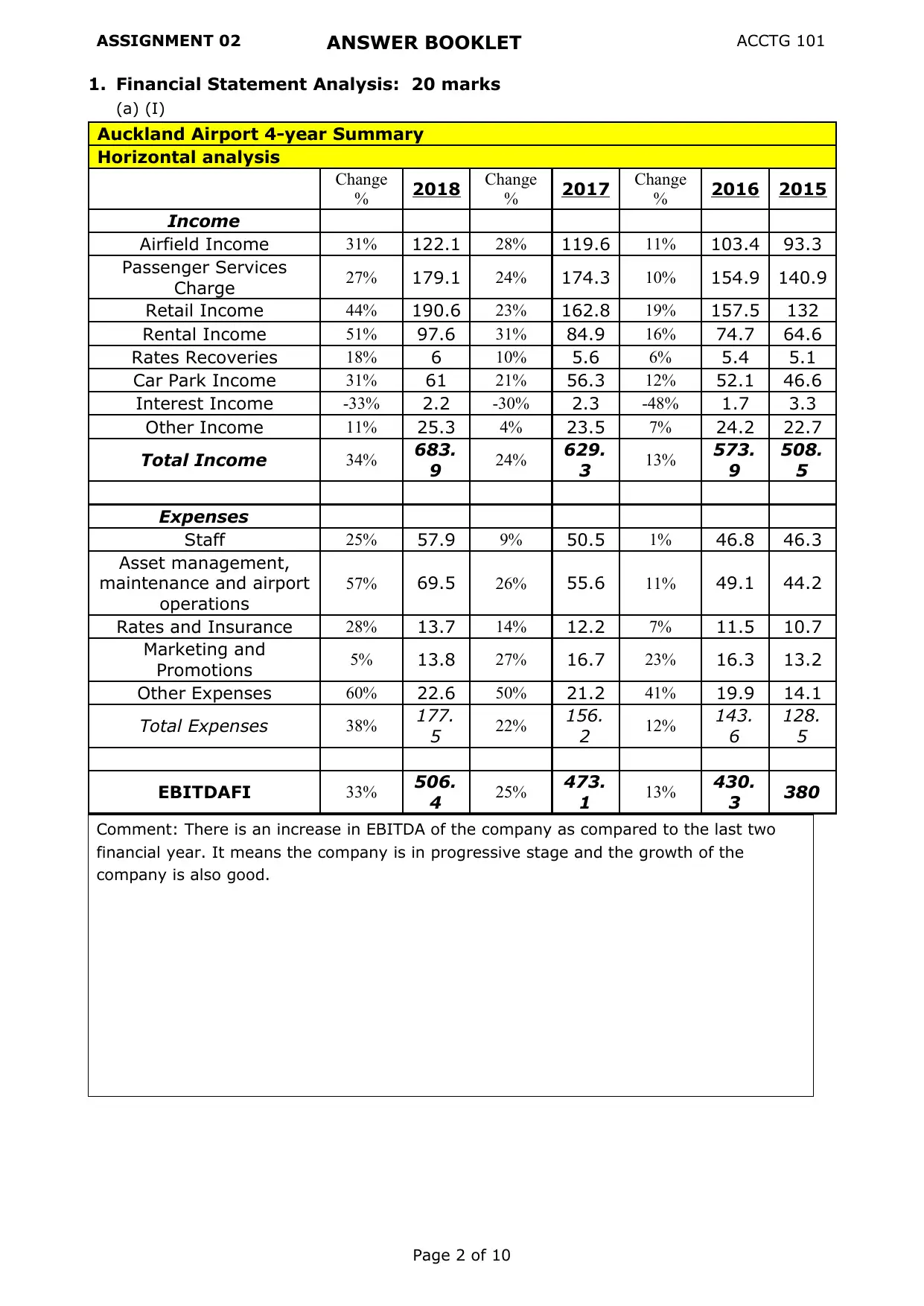
ASSIGNMENT 02 ANSWER BOOKLET ACCTG 101
1. Financial Statement Analysis: 20 marks
(a) (I)
Auckland Airport 4-year Summary
Horizontal analysis
Change
% 2018 Change
% 2017 Change
% 2016 2015
Income
Airfield Income 31% 122.1 28% 119.6 11% 103.4 93.3
Passenger Services
Charge 27% 179.1 24% 174.3 10% 154.9 140.9
Retail Income 44% 190.6 23% 162.8 19% 157.5 132
Rental Income 51% 97.6 31% 84.9 16% 74.7 64.6
Rates Recoveries 18% 6 10% 5.6 6% 5.4 5.1
Car Park Income 31% 61 21% 56.3 12% 52.1 46.6
Interest Income -33% 2.2 -30% 2.3 -48% 1.7 3.3
Other Income 11% 25.3 4% 23.5 7% 24.2 22.7
Total Income 34% 683.
9 24% 629.
3 13% 573.
9
508.
5
Expenses
Staff 25% 57.9 9% 50.5 1% 46.8 46.3
Asset management,
maintenance and airport
operations
57% 69.5 26% 55.6 11% 49.1 44.2
Rates and Insurance 28% 13.7 14% 12.2 7% 11.5 10.7
Marketing and
Promotions 5% 13.8 27% 16.7 23% 16.3 13.2
Other Expenses 60% 22.6 50% 21.2 41% 19.9 14.1
Total Expenses 38% 177.
5 22% 156.
2 12% 143.
6
128.
5
EBITDAFI 33% 506.
4 25% 473.
1 13% 430.
3 380
Comment: There is an increase in EBITDA of the company as compared to the last two
financial year. It means the company is in progressive stage and the growth of the
company is also good.
Page 2 of 10
1. Financial Statement Analysis: 20 marks
(a) (I)
Auckland Airport 4-year Summary
Horizontal analysis
Change
% 2018 Change
% 2017 Change
% 2016 2015
Income
Airfield Income 31% 122.1 28% 119.6 11% 103.4 93.3
Passenger Services
Charge 27% 179.1 24% 174.3 10% 154.9 140.9
Retail Income 44% 190.6 23% 162.8 19% 157.5 132
Rental Income 51% 97.6 31% 84.9 16% 74.7 64.6
Rates Recoveries 18% 6 10% 5.6 6% 5.4 5.1
Car Park Income 31% 61 21% 56.3 12% 52.1 46.6
Interest Income -33% 2.2 -30% 2.3 -48% 1.7 3.3
Other Income 11% 25.3 4% 23.5 7% 24.2 22.7
Total Income 34% 683.
9 24% 629.
3 13% 573.
9
508.
5
Expenses
Staff 25% 57.9 9% 50.5 1% 46.8 46.3
Asset management,
maintenance and airport
operations
57% 69.5 26% 55.6 11% 49.1 44.2
Rates and Insurance 28% 13.7 14% 12.2 7% 11.5 10.7
Marketing and
Promotions 5% 13.8 27% 16.7 23% 16.3 13.2
Other Expenses 60% 22.6 50% 21.2 41% 19.9 14.1
Total Expenses 38% 177.
5 22% 156.
2 12% 143.
6
128.
5
EBITDAFI 33% 506.
4 25% 473.
1 13% 430.
3 380
Comment: There is an increase in EBITDA of the company as compared to the last two
financial year. It means the company is in progressive stage and the growth of the
company is also good.
Page 2 of 10
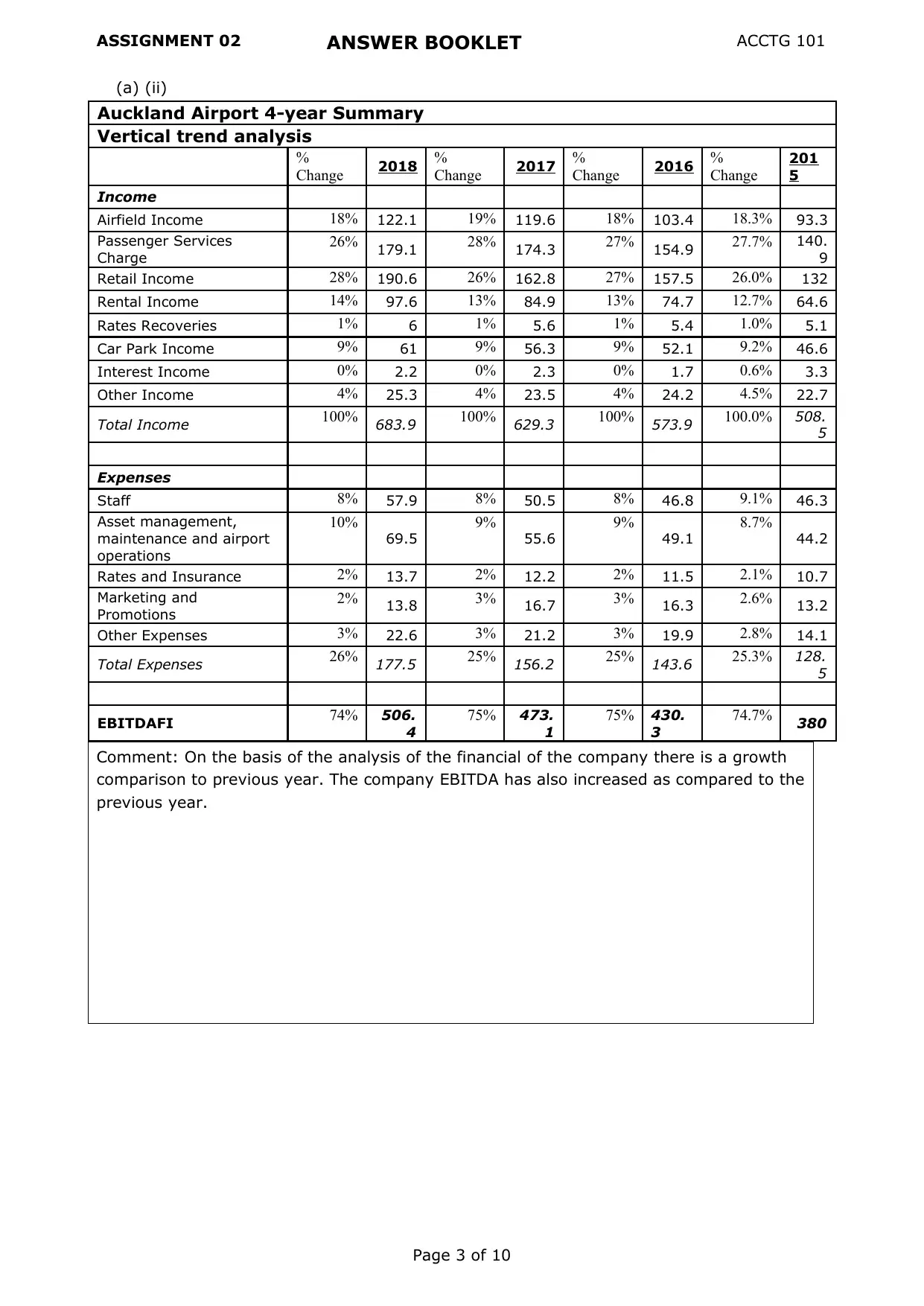
ASSIGNMENT 02 ANSWER BOOKLET ACCTG 101
(a) (ii)
Auckland Airport 4-year Summary
Vertical trend analysis
%
Change 2018 %
Change 2017 %
Change 2016 %
Change
201
5
Income
Airfield Income 18% 122.1 19% 119.6 18% 103.4 18.3% 93.3
Passenger Services
Charge
26% 179.1 28% 174.3 27% 154.9 27.7% 140.
9
Retail Income 28% 190.6 26% 162.8 27% 157.5 26.0% 132
Rental Income 14% 97.6 13% 84.9 13% 74.7 12.7% 64.6
Rates Recoveries 1% 6 1% 5.6 1% 5.4 1.0% 5.1
Car Park Income 9% 61 9% 56.3 9% 52.1 9.2% 46.6
Interest Income 0% 2.2 0% 2.3 0% 1.7 0.6% 3.3
Other Income 4% 25.3 4% 23.5 4% 24.2 4.5% 22.7
Total Income 100% 683.9 100% 629.3 100% 573.9 100.0% 508.
5
Expenses
Staff 8% 57.9 8% 50.5 8% 46.8 9.1% 46.3
Asset management,
maintenance and airport
operations
10%
69.5
9%
55.6
9%
49.1
8.7%
44.2
Rates and Insurance 2% 13.7 2% 12.2 2% 11.5 2.1% 10.7
Marketing and
Promotions
2% 13.8 3% 16.7 3% 16.3 2.6% 13.2
Other Expenses 3% 22.6 3% 21.2 3% 19.9 2.8% 14.1
Total Expenses 26% 177.5 25% 156.2 25% 143.6 25.3% 128.
5
EBITDAFI 74% 506.
4
75% 473.
1
75% 430.
3
74.7% 380
Comment: On the basis of the analysis of the financial of the company there is a growth
comparison to previous year. The company EBITDA has also increased as compared to the
previous year.
Page 3 of 10
(a) (ii)
Auckland Airport 4-year Summary
Vertical trend analysis
%
Change 2018 %
Change 2017 %
Change 2016 %
Change
201
5
Income
Airfield Income 18% 122.1 19% 119.6 18% 103.4 18.3% 93.3
Passenger Services
Charge
26% 179.1 28% 174.3 27% 154.9 27.7% 140.
9
Retail Income 28% 190.6 26% 162.8 27% 157.5 26.0% 132
Rental Income 14% 97.6 13% 84.9 13% 74.7 12.7% 64.6
Rates Recoveries 1% 6 1% 5.6 1% 5.4 1.0% 5.1
Car Park Income 9% 61 9% 56.3 9% 52.1 9.2% 46.6
Interest Income 0% 2.2 0% 2.3 0% 1.7 0.6% 3.3
Other Income 4% 25.3 4% 23.5 4% 24.2 4.5% 22.7
Total Income 100% 683.9 100% 629.3 100% 573.9 100.0% 508.
5
Expenses
Staff 8% 57.9 8% 50.5 8% 46.8 9.1% 46.3
Asset management,
maintenance and airport
operations
10%
69.5
9%
55.6
9%
49.1
8.7%
44.2
Rates and Insurance 2% 13.7 2% 12.2 2% 11.5 2.1% 10.7
Marketing and
Promotions
2% 13.8 3% 16.7 3% 16.3 2.6% 13.2
Other Expenses 3% 22.6 3% 21.2 3% 19.9 2.8% 14.1
Total Expenses 26% 177.5 25% 156.2 25% 143.6 25.3% 128.
5
EBITDAFI 74% 506.
4
75% 473.
1
75% 430.
3
74.7% 380
Comment: On the basis of the analysis of the financial of the company there is a growth
comparison to previous year. The company EBITDA has also increased as compared to the
previous year.
Page 3 of 10
⊘ This is a preview!⊘
Do you want full access?
Subscribe today to unlock all pages.

Trusted by 1+ million students worldwide
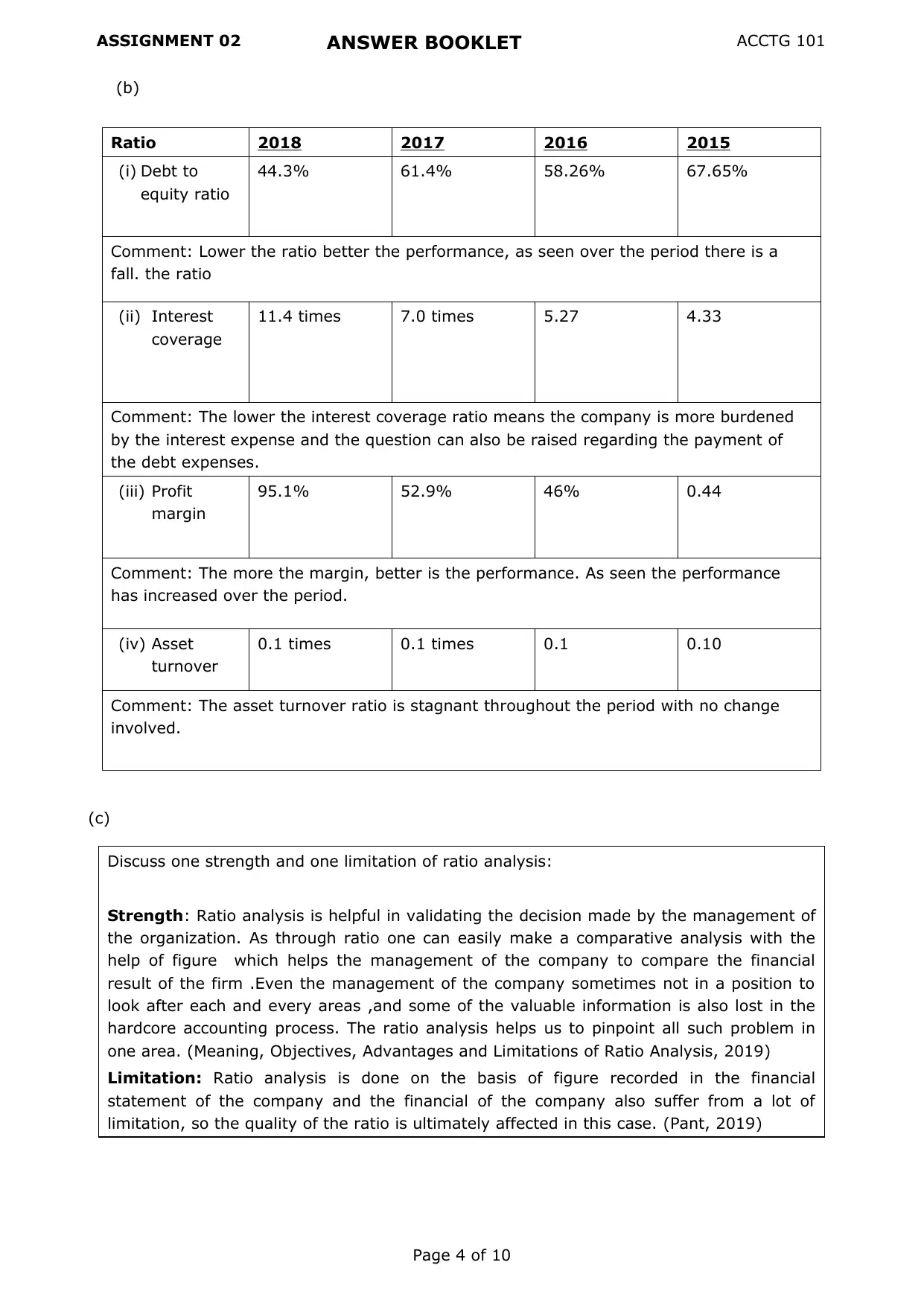
ASSIGNMENT 02 ANSWER BOOKLET ACCTG 101
(b)
Ratio 2018 2017 2016 2015
(i) Debt to
equity ratio
44.3% 61.4% 58.26% 67.65%
Comment: Lower the ratio better the performance, as seen over the period there is a
fall. the ratio
(ii) Interest
coverage
11.4 times 7.0 times 5.27 4.33
Comment: The lower the interest coverage ratio means the company is more burdened
by the interest expense and the question can also be raised regarding the payment of
the debt expenses.
(iii) Profit
margin
95.1% 52.9% 46% 0.44
Comment: The more the margin, better is the performance. As seen the performance
has increased over the period.
(iv) Asset
turnover
0.1 times 0.1 times 0.1 0.10
Comment: The asset turnover ratio is stagnant throughout the period with no change
involved.
(c)
Discuss one strength and one limitation of ratio analysis:
Strength: Ratio analysis is helpful in validating the decision made by the management of
the organization. As through ratio one can easily make a comparative analysis with the
help of figure which helps the management of the company to compare the financial
result of the firm .Even the management of the company sometimes not in a position to
look after each and every areas ,and some of the valuable information is also lost in the
hardcore accounting process. The ratio analysis helps us to pinpoint all such problem in
one area. (Meaning, Objectives, Advantages and Limitations of Ratio Analysis, 2019)
Limitation: Ratio analysis is done on the basis of figure recorded in the financial
statement of the company and the financial of the company also suffer from a lot of
limitation, so the quality of the ratio is ultimately affected in this case. (Pant, 2019)
Page 4 of 10
(b)
Ratio 2018 2017 2016 2015
(i) Debt to
equity ratio
44.3% 61.4% 58.26% 67.65%
Comment: Lower the ratio better the performance, as seen over the period there is a
fall. the ratio
(ii) Interest
coverage
11.4 times 7.0 times 5.27 4.33
Comment: The lower the interest coverage ratio means the company is more burdened
by the interest expense and the question can also be raised regarding the payment of
the debt expenses.
(iii) Profit
margin
95.1% 52.9% 46% 0.44
Comment: The more the margin, better is the performance. As seen the performance
has increased over the period.
(iv) Asset
turnover
0.1 times 0.1 times 0.1 0.10
Comment: The asset turnover ratio is stagnant throughout the period with no change
involved.
(c)
Discuss one strength and one limitation of ratio analysis:
Strength: Ratio analysis is helpful in validating the decision made by the management of
the organization. As through ratio one can easily make a comparative analysis with the
help of figure which helps the management of the company to compare the financial
result of the firm .Even the management of the company sometimes not in a position to
look after each and every areas ,and some of the valuable information is also lost in the
hardcore accounting process. The ratio analysis helps us to pinpoint all such problem in
one area. (Meaning, Objectives, Advantages and Limitations of Ratio Analysis, 2019)
Limitation: Ratio analysis is done on the basis of figure recorded in the financial
statement of the company and the financial of the company also suffer from a lot of
limitation, so the quality of the ratio is ultimately affected in this case. (Pant, 2019)
Page 4 of 10
Paraphrase This Document
Need a fresh take? Get an instant paraphrase of this document with our AI Paraphraser
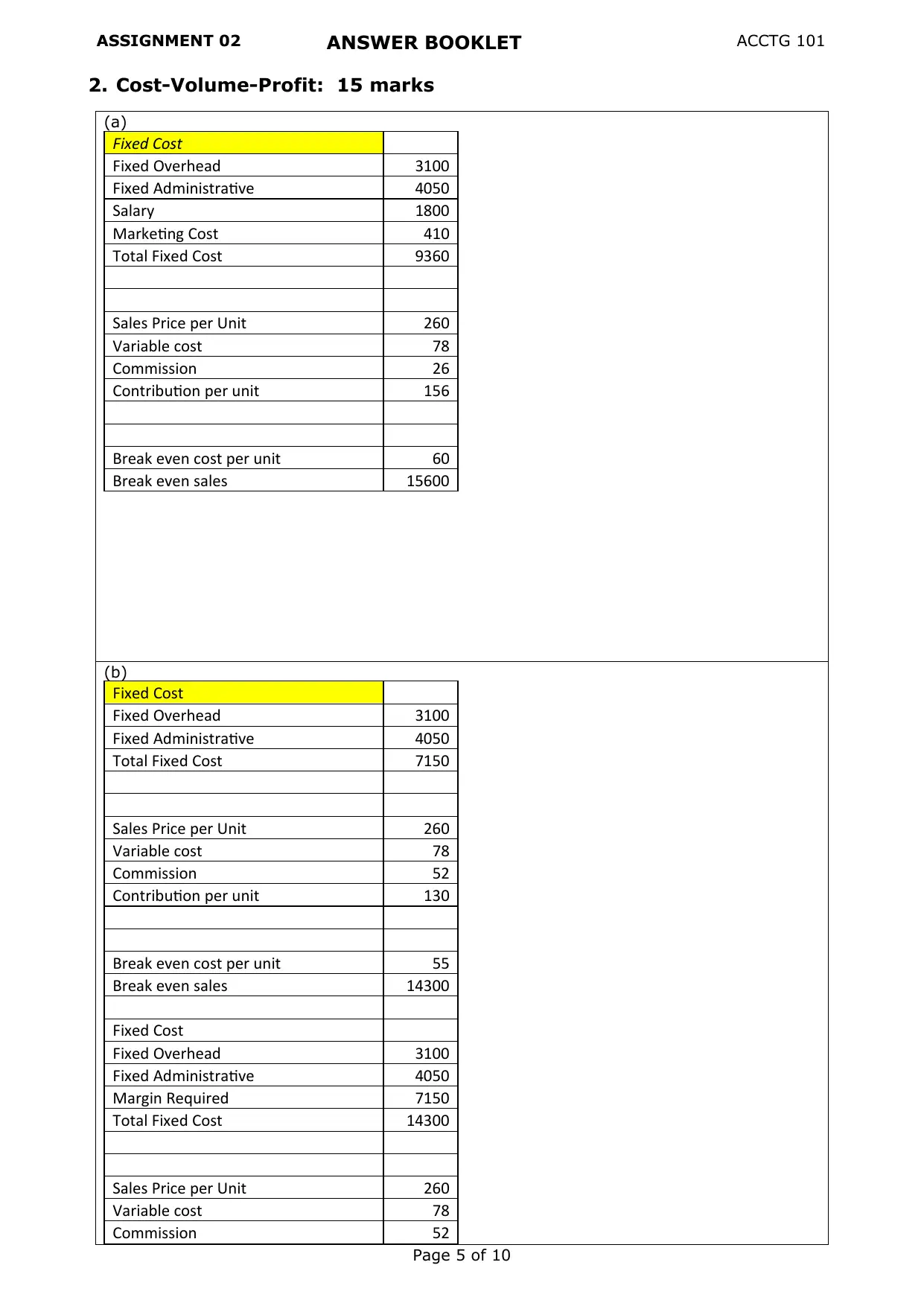
ASSIGNMENT 02 ANSWER BOOKLET ACCTG 101
2. Cost-Volume-Profit: 15 marks
(a)
Fixed Cost
Fixed Overhead 3100
Fixed Administrative 4050
Salary 1800
Marketing Cost 410
Total Fixed Cost 9360
Sales Price per Unit 260
Variable cost 78
Commission 26
Contribution per unit 156
Break even cost per unit 60
Break even sales 15600
(b)
Fixed Cost
Fixed Overhead 3100
Fixed Administrative 4050
Total Fixed Cost 7150
Sales Price per Unit 260
Variable cost 78
Commission 52
Contribution per unit 130
Break even cost per unit 55
Break even sales 14300
Fixed Cost
Fixed Overhead 3100
Fixed Administrative 4050
Margin Required 7150
Total Fixed Cost 14300
Sales Price per Unit 260
Variable cost 78
Commission 52
Page 5 of 10
2. Cost-Volume-Profit: 15 marks
(a)
Fixed Cost
Fixed Overhead 3100
Fixed Administrative 4050
Salary 1800
Marketing Cost 410
Total Fixed Cost 9360
Sales Price per Unit 260
Variable cost 78
Commission 26
Contribution per unit 156
Break even cost per unit 60
Break even sales 15600
(b)
Fixed Cost
Fixed Overhead 3100
Fixed Administrative 4050
Total Fixed Cost 7150
Sales Price per Unit 260
Variable cost 78
Commission 52
Contribution per unit 130
Break even cost per unit 55
Break even sales 14300
Fixed Cost
Fixed Overhead 3100
Fixed Administrative 4050
Margin Required 7150
Total Fixed Cost 14300
Sales Price per Unit 260
Variable cost 78
Commission 52
Page 5 of 10
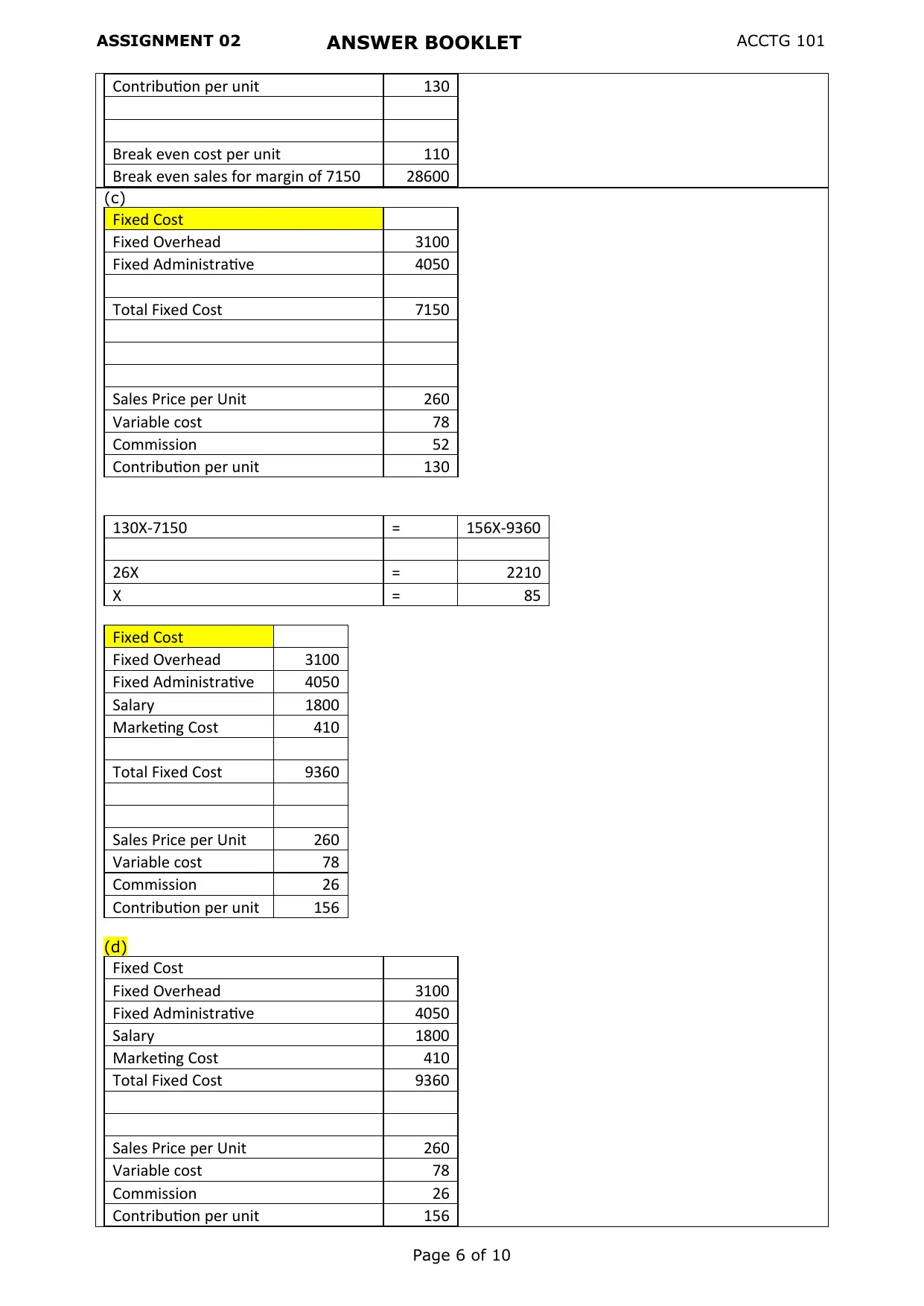
ASSIGNMENT 02 ANSWER BOOKLET ACCTG 101
Contribution per unit 130
Break even cost per unit 110
Break even sales for margin of 7150 28600
(c)
Fixed Cost
Fixed Overhead 3100
Fixed Administrative 4050
Total Fixed Cost 7150
Sales Price per Unit 260
Variable cost 78
Commission 52
Contribution per unit 130
130X-7150 = 156X-9360
26X = 2210
X = 85
Fixed Cost
Fixed Overhead 3100
Fixed Administrative 4050
Salary 1800
Marketing Cost 410
Total Fixed Cost 9360
Sales Price per Unit 260
Variable cost 78
Commission 26
Contribution per unit 156
(d)
Fixed Cost
Fixed Overhead 3100
Fixed Administrative 4050
Salary 1800
Marketing Cost 410
Total Fixed Cost 9360
Sales Price per Unit 260
Variable cost 78
Commission 26
Contribution per unit 156
Page 6 of 10
Contribution per unit 130
Break even cost per unit 110
Break even sales for margin of 7150 28600
(c)
Fixed Cost
Fixed Overhead 3100
Fixed Administrative 4050
Total Fixed Cost 7150
Sales Price per Unit 260
Variable cost 78
Commission 52
Contribution per unit 130
130X-7150 = 156X-9360
26X = 2210
X = 85
Fixed Cost
Fixed Overhead 3100
Fixed Administrative 4050
Salary 1800
Marketing Cost 410
Total Fixed Cost 9360
Sales Price per Unit 260
Variable cost 78
Commission 26
Contribution per unit 156
(d)
Fixed Cost
Fixed Overhead 3100
Fixed Administrative 4050
Salary 1800
Marketing Cost 410
Total Fixed Cost 9360
Sales Price per Unit 260
Variable cost 78
Commission 26
Contribution per unit 156
Page 6 of 10
⊘ This is a preview!⊘
Do you want full access?
Subscribe today to unlock all pages.

Trusted by 1+ million students worldwide
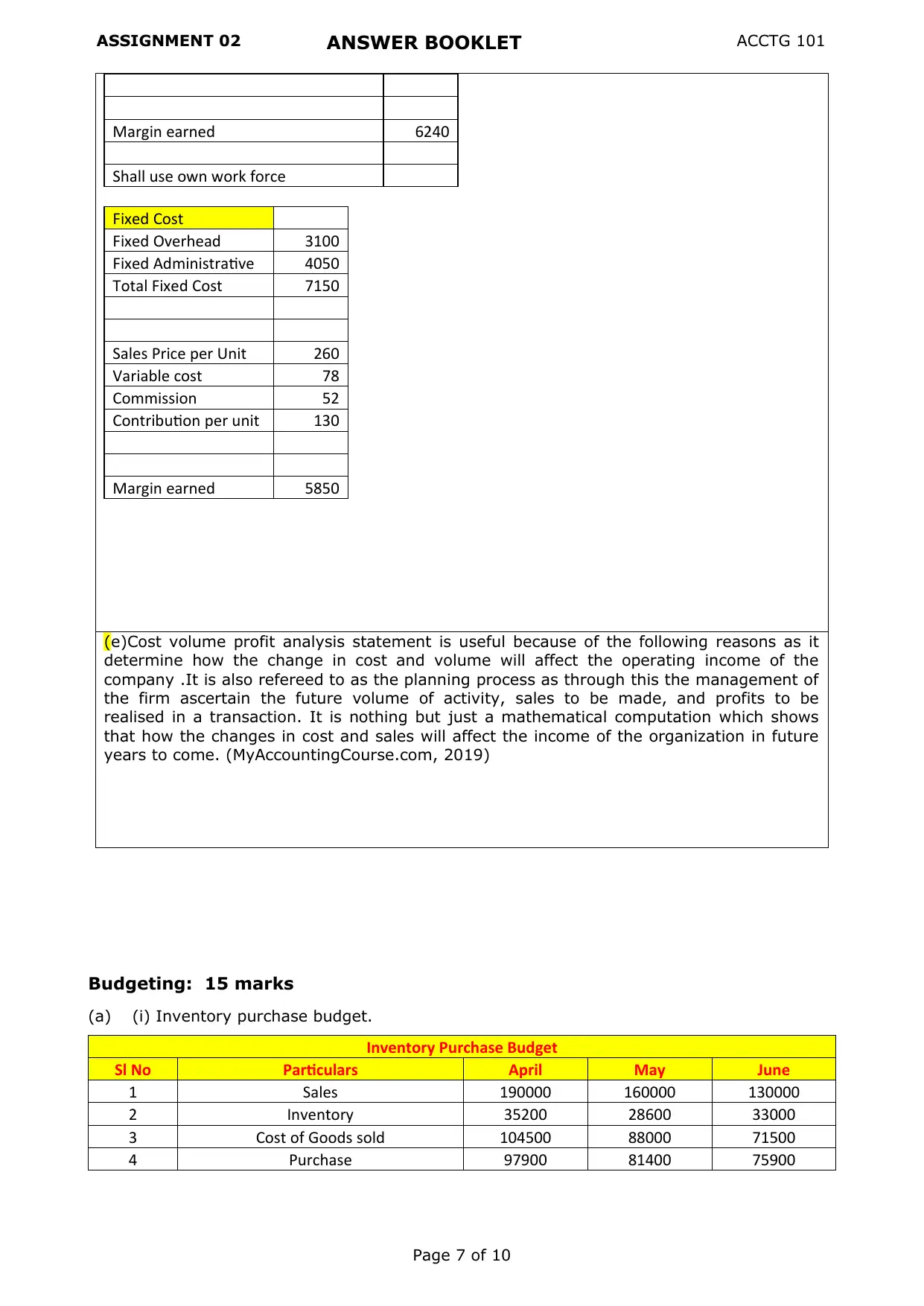
ASSIGNMENT 02 ANSWER BOOKLET ACCTG 101
Margin earned 6240
Shall use own work force
Fixed Cost
Fixed Overhead 3100
Fixed Administrative 4050
Total Fixed Cost 7150
Sales Price per Unit 260
Variable cost 78
Commission 52
Contribution per unit 130
Margin earned 5850
(e)Cost volume profit analysis statement is useful because of the following reasons as it
determine how the change in cost and volume will affect the operating income of the
company .It is also refereed to as the planning process as through this the management of
the firm ascertain the future volume of activity, sales to be made, and profits to be
realised in a transaction. It is nothing but just a mathematical computation which shows
that how the changes in cost and sales will affect the income of the organization in future
years to come. (MyAccountingCourse.com, 2019)
Budgeting: 15 marks
(a) (i) Inventory purchase budget.
Inventory Purchase Budget
Sl No Particulars April May June
1 Sales 190000 160000 130000
2 Inventory 35200 28600 33000
3 Cost of Goods sold 104500 88000 71500
4 Purchase 97900 81400 75900
Page 7 of 10
Margin earned 6240
Shall use own work force
Fixed Cost
Fixed Overhead 3100
Fixed Administrative 4050
Total Fixed Cost 7150
Sales Price per Unit 260
Variable cost 78
Commission 52
Contribution per unit 130
Margin earned 5850
(e)Cost volume profit analysis statement is useful because of the following reasons as it
determine how the change in cost and volume will affect the operating income of the
company .It is also refereed to as the planning process as through this the management of
the firm ascertain the future volume of activity, sales to be made, and profits to be
realised in a transaction. It is nothing but just a mathematical computation which shows
that how the changes in cost and sales will affect the income of the organization in future
years to come. (MyAccountingCourse.com, 2019)
Budgeting: 15 marks
(a) (i) Inventory purchase budget.
Inventory Purchase Budget
Sl No Particulars April May June
1 Sales 190000 160000 130000
2 Inventory 35200 28600 33000
3 Cost of Goods sold 104500 88000 71500
4 Purchase 97900 81400 75900
Page 7 of 10
Paraphrase This Document
Need a fresh take? Get an instant paraphrase of this document with our AI Paraphraser
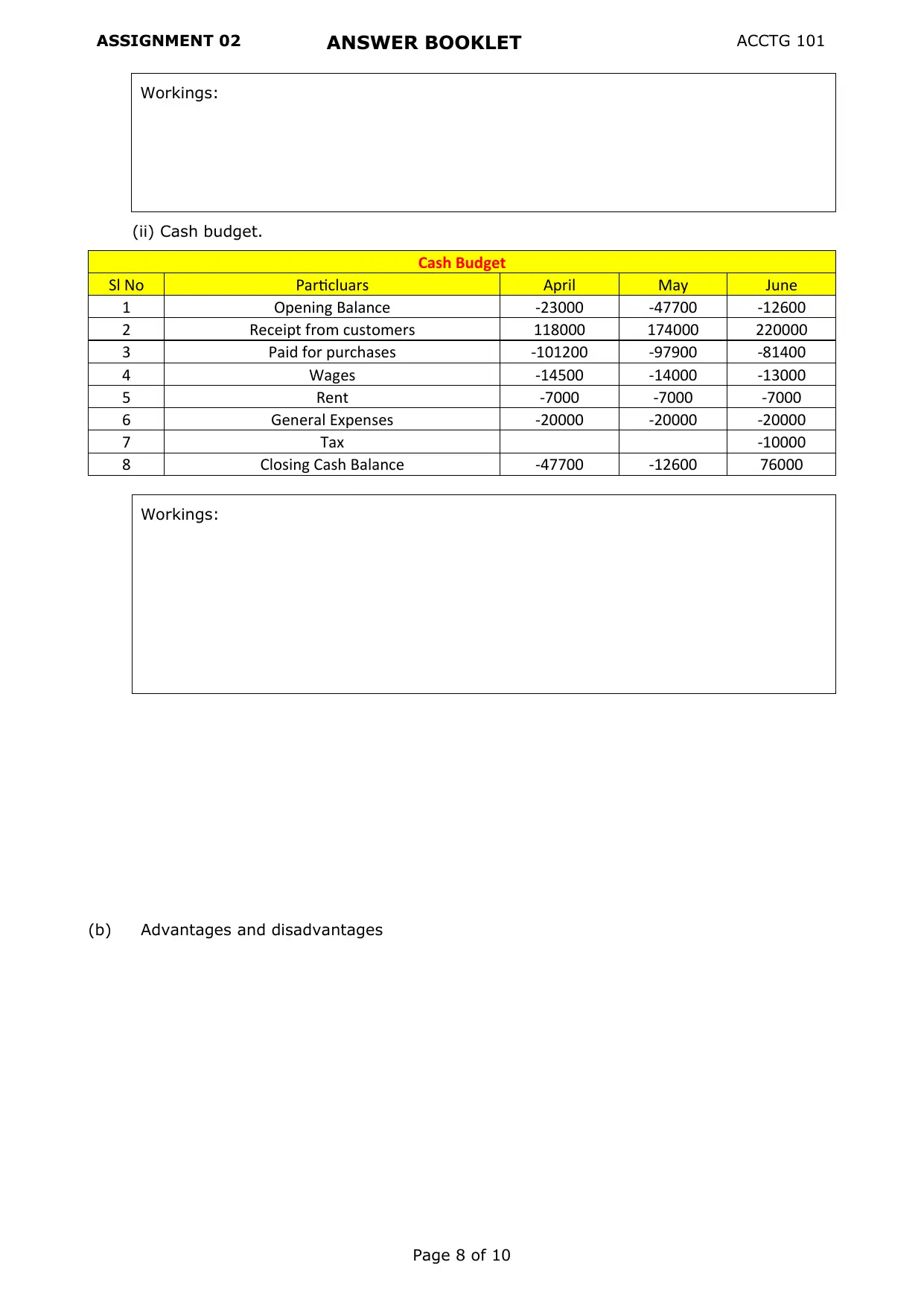
ASSIGNMENT 02 ANSWER BOOKLET ACCTG 101
Workings:
(ii) Cash budget.
Cash Budget
Sl No Particluars April May June
1 Opening Balance -23000 -47700 -12600
2 Receipt from customers 118000 174000 220000
3 Paid for purchases -101200 -97900 -81400
4 Wages -14500 -14000 -13000
5 Rent -7000 -7000 -7000
6 General Expenses -20000 -20000 -20000
7 Tax -10000
8 Closing Cash Balance -47700 -12600 76000
Workings:
(b) Advantages and disadvantages
Page 8 of 10
Workings:
(ii) Cash budget.
Cash Budget
Sl No Particluars April May June
1 Opening Balance -23000 -47700 -12600
2 Receipt from customers 118000 174000 220000
3 Paid for purchases -101200 -97900 -81400
4 Wages -14500 -14000 -13000
5 Rent -7000 -7000 -7000
6 General Expenses -20000 -20000 -20000
7 Tax -10000
8 Closing Cash Balance -47700 -12600 76000
Workings:
(b) Advantages and disadvantages
Page 8 of 10
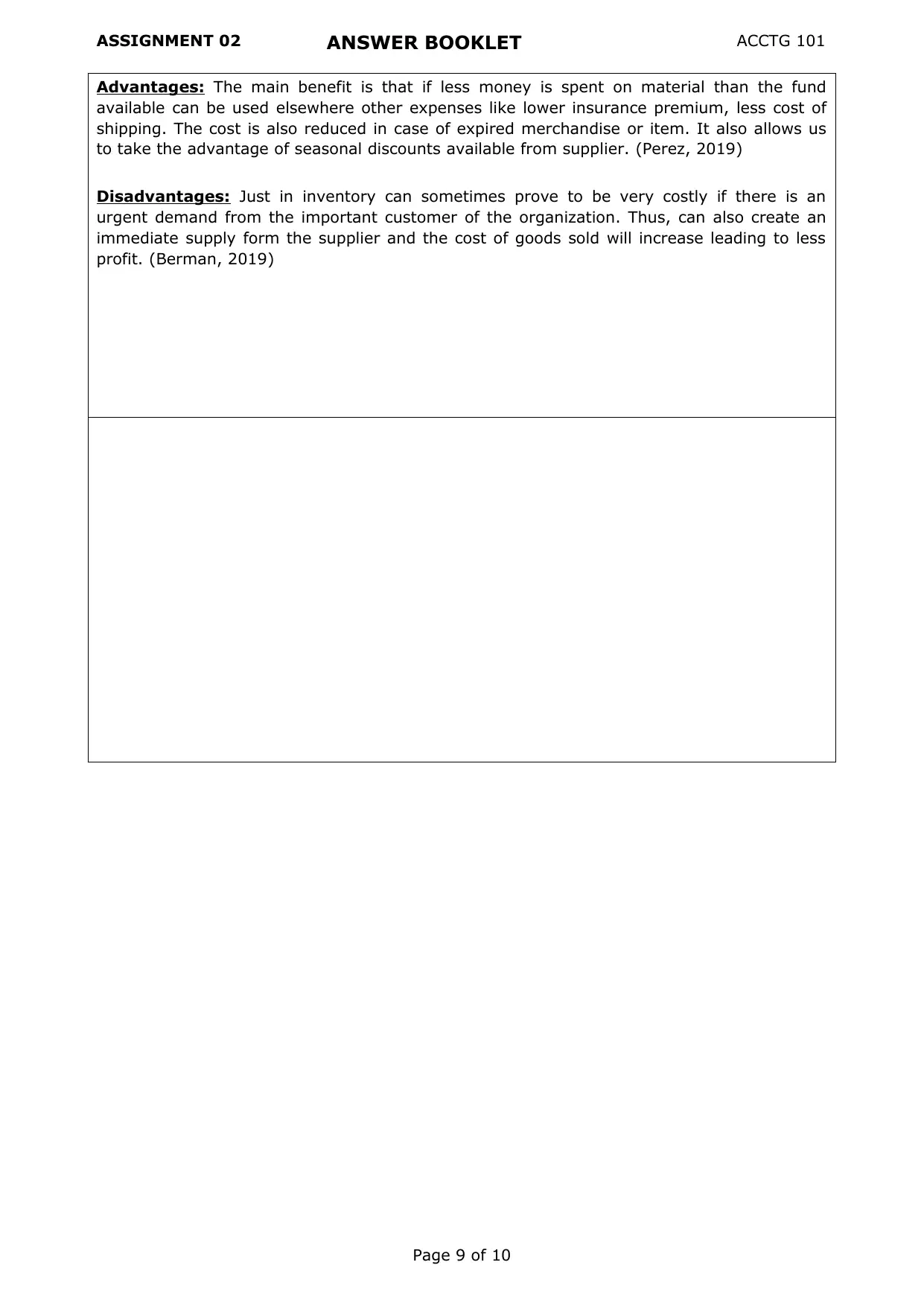
ASSIGNMENT 02 ANSWER BOOKLET ACCTG 101
Advantages: The main benefit is that if less money is spent on material than the fund
available can be used elsewhere other expenses like lower insurance premium, less cost of
shipping. The cost is also reduced in case of expired merchandise or item. It also allows us
to take the advantage of seasonal discounts available from supplier. (Perez, 2019)
Disadvantages: Just in inventory can sometimes prove to be very costly if there is an
urgent demand from the important customer of the organization. Thus, can also create an
immediate supply form the supplier and the cost of goods sold will increase leading to less
profit. (Berman, 2019)
Page 9 of 10
Advantages: The main benefit is that if less money is spent on material than the fund
available can be used elsewhere other expenses like lower insurance premium, less cost of
shipping. The cost is also reduced in case of expired merchandise or item. It also allows us
to take the advantage of seasonal discounts available from supplier. (Perez, 2019)
Disadvantages: Just in inventory can sometimes prove to be very costly if there is an
urgent demand from the important customer of the organization. Thus, can also create an
immediate supply form the supplier and the cost of goods sold will increase leading to less
profit. (Berman, 2019)
Page 9 of 10
⊘ This is a preview!⊘
Do you want full access?
Subscribe today to unlock all pages.

Trusted by 1+ million students worldwide
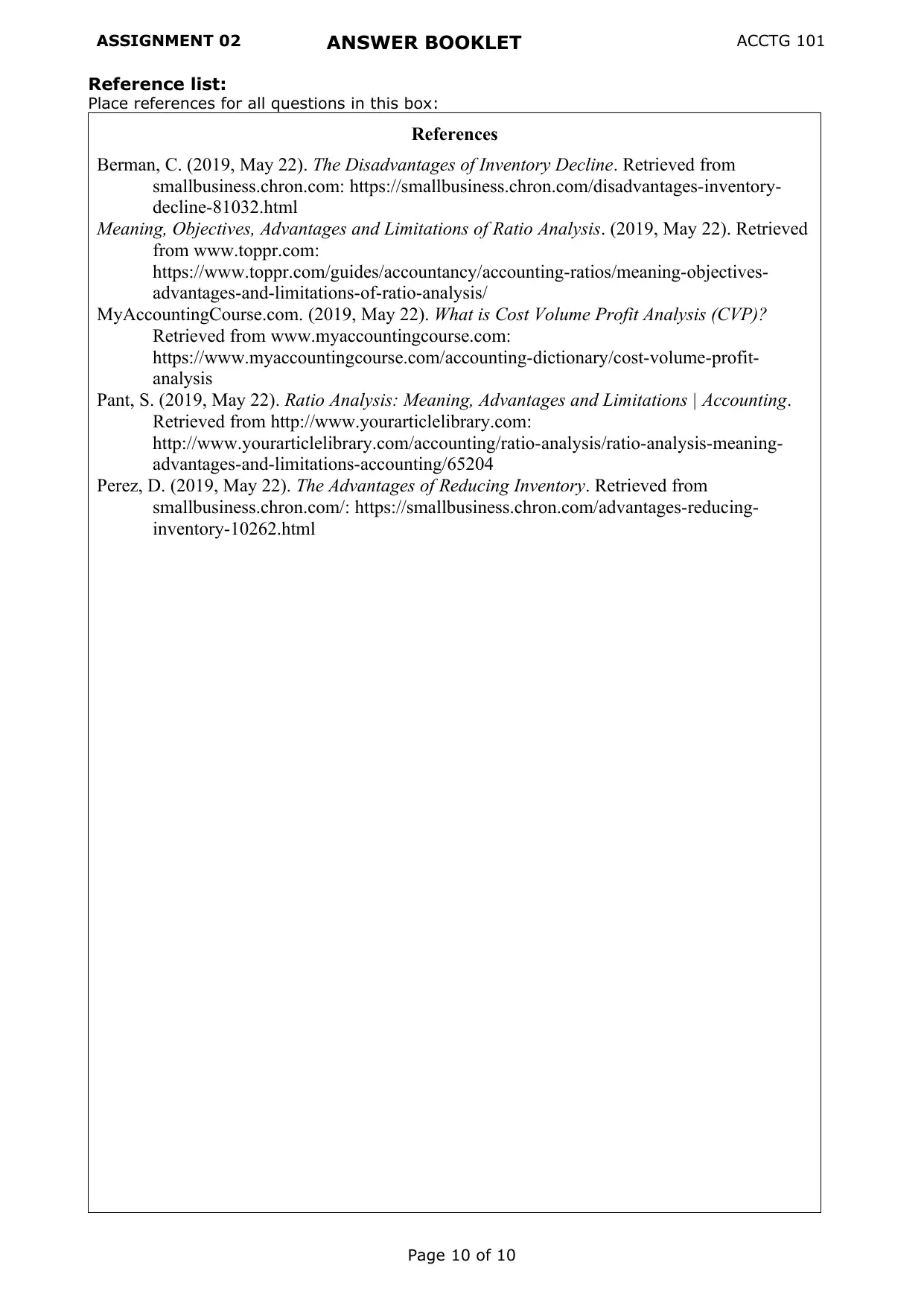
ASSIGNMENT 02 ANSWER BOOKLET ACCTG 101
Reference list:
Place references for all questions in this box:
References
Berman, C. (2019, May 22). The Disadvantages of Inventory Decline. Retrieved from
smallbusiness.chron.com: https://smallbusiness.chron.com/disadvantages-inventory-
decline-81032.html
Meaning, Objectives, Advantages and Limitations of Ratio Analysis. (2019, May 22). Retrieved
from www.toppr.com:
https://www.toppr.com/guides/accountancy/accounting-ratios/meaning-objectives-
advantages-and-limitations-of-ratio-analysis/
MyAccountingCourse.com. (2019, May 22). What is Cost Volume Profit Analysis (CVP)?
Retrieved from www.myaccountingcourse.com:
https://www.myaccountingcourse.com/accounting-dictionary/cost-volume-profit-
analysis
Pant, S. (2019, May 22). Ratio Analysis: Meaning, Advantages and Limitations | Accounting.
Retrieved from http://www.yourarticlelibrary.com:
http://www.yourarticlelibrary.com/accounting/ratio-analysis/ratio-analysis-meaning-
advantages-and-limitations-accounting/65204
Perez, D. (2019, May 22). The Advantages of Reducing Inventory. Retrieved from
smallbusiness.chron.com/: https://smallbusiness.chron.com/advantages-reducing-
inventory-10262.html
Page 10 of 10
Reference list:
Place references for all questions in this box:
References
Berman, C. (2019, May 22). The Disadvantages of Inventory Decline. Retrieved from
smallbusiness.chron.com: https://smallbusiness.chron.com/disadvantages-inventory-
decline-81032.html
Meaning, Objectives, Advantages and Limitations of Ratio Analysis. (2019, May 22). Retrieved
from www.toppr.com:
https://www.toppr.com/guides/accountancy/accounting-ratios/meaning-objectives-
advantages-and-limitations-of-ratio-analysis/
MyAccountingCourse.com. (2019, May 22). What is Cost Volume Profit Analysis (CVP)?
Retrieved from www.myaccountingcourse.com:
https://www.myaccountingcourse.com/accounting-dictionary/cost-volume-profit-
analysis
Pant, S. (2019, May 22). Ratio Analysis: Meaning, Advantages and Limitations | Accounting.
Retrieved from http://www.yourarticlelibrary.com:
http://www.yourarticlelibrary.com/accounting/ratio-analysis/ratio-analysis-meaning-
advantages-and-limitations-accounting/65204
Perez, D. (2019, May 22). The Advantages of Reducing Inventory. Retrieved from
smallbusiness.chron.com/: https://smallbusiness.chron.com/advantages-reducing-
inventory-10262.html
Page 10 of 10
1 out of 10
Your All-in-One AI-Powered Toolkit for Academic Success.
+13062052269
info@desklib.com
Available 24*7 on WhatsApp / Email
![[object Object]](/_next/static/media/star-bottom.7253800d.svg)
Unlock your academic potential
Copyright © 2020–2025 A2Z Services. All Rights Reserved. Developed and managed by ZUCOL.